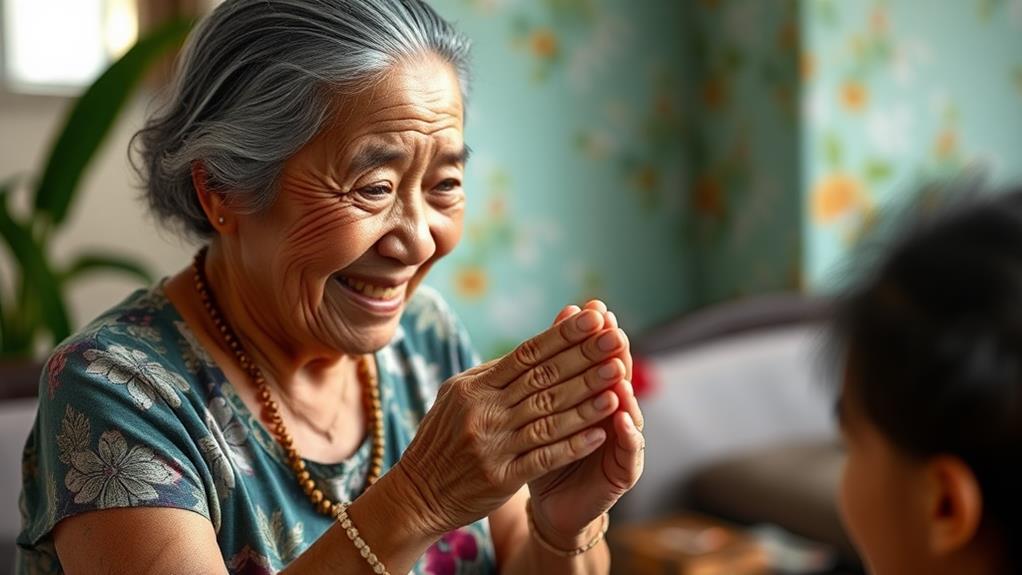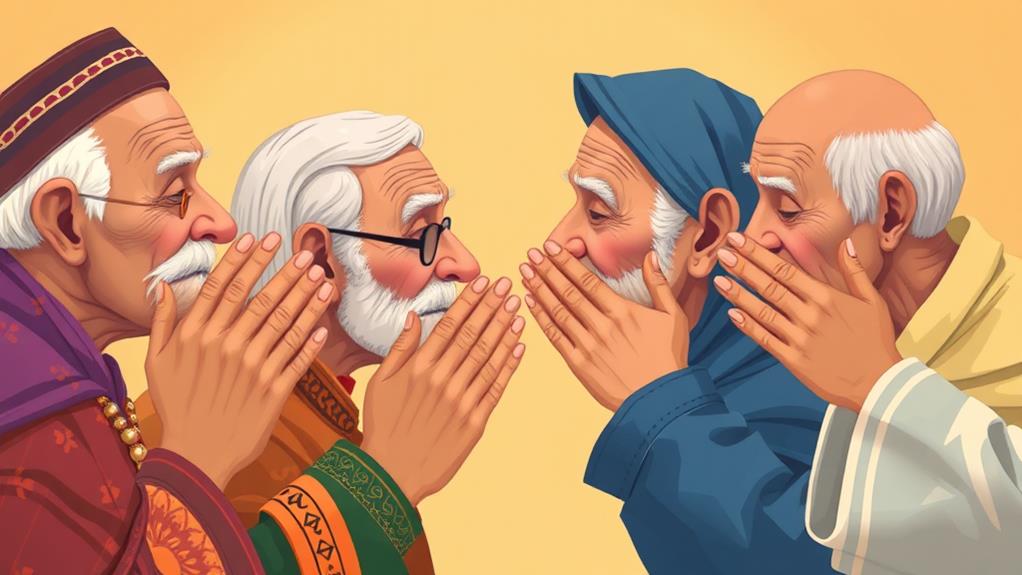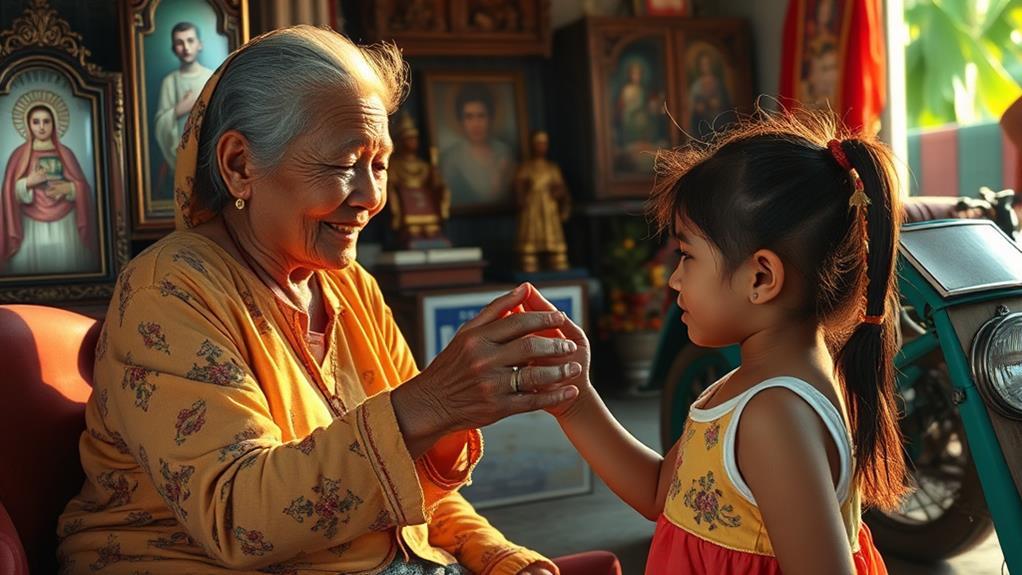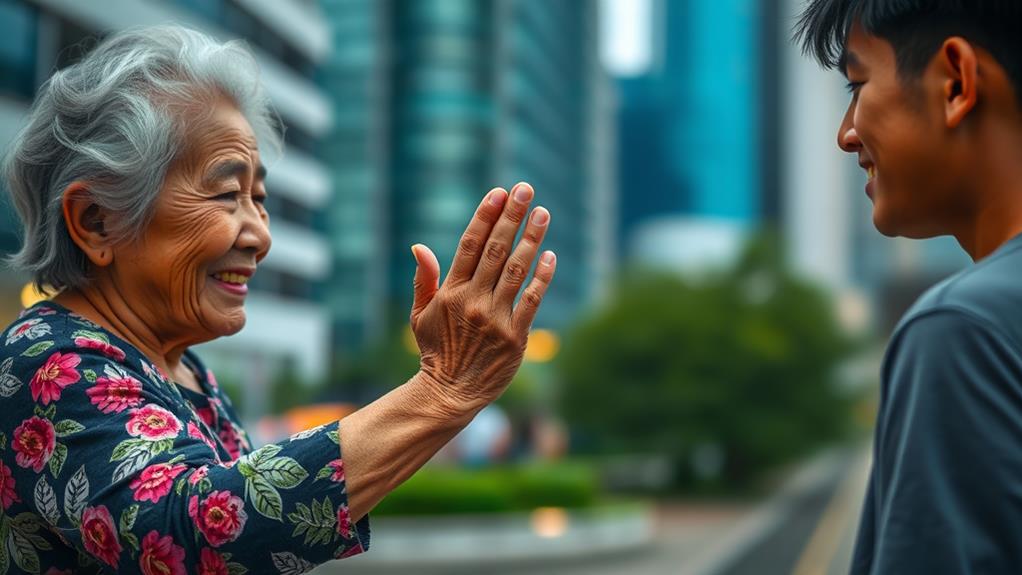Mano Po: A Gesture of Respect for Elders
When interacting with elders in the Philippines, you may encounter a traditional gesture of respect called mano po. This gesture involves extending one's hand, which the younger person presses to their forehead, accompanied by a respectful "mano po."
Mano po is rooted in both Spanish colonization and Eastern customs, conveying reverence for an elder's wisdom and experience. By performing Mano po, you not only show respect but also acknowledge intergenerational bonds and familial loyalty, symbolizing appreciation and gratitude towards elders.
This meaningful gesture holds significant cultural importance in Filipino tradition, highlighting the importance of respect for elders and their valuable life experiences.
Definition of Mano Po

What is Mano Po?
When entering an elder's home in the Philippines, you'll likely witness a traditional gesture of respect and deference called "mano po". This gesture involves taking an elder's hand and pressing it to your forehead to show respect and request blessings.
Meaning of Mano Po
The term "mano" translates to "hand" in Spanish, while "po" is a Filipino word indicating respect, together meaning "your hand please". This deliberate act conveys reverence and admiration for the elder's wisdom and experience.
Cultural Significance of Mano Po
As a gesture, "mano po" is a powerful expression of cultural values, emphasizing the importance of honoring one's elders.
It's a deliberate display of respect initiated by younger individuals towards their elders, often accompanied by the phrase "mano po" itself. This highlights the value placed on familial loyalty and community respect in Filipino culture and social interactions.
Cultural Significance in the Philippines
Respect for Elders: The Significance of Mano Po in Filipino Culture
In the Philippines, the mano po gesture is a deeply ingrained tradition that reflects the high value placed on honoring the wisdom and experience of elders. This traditional practice involves taking an elder's hand and pressing it to the forehead, seeking their blessings and respect.
The mano po gesture is rooted in both Spanish colonization and Eastern customs, and has become an integral part of Filipino culture. When initiating the gesture, one says "Mano po," which translates to "your hand, please," and is typically performed with the right hand.
While primarily practiced among family members, mano po can also extend to acquaintances, highlighting the broader cultural emphasis on respect within the community. This gesture is especially important when entering an elder's home, as it signifies a polite acknowledgment of their status and the cultural norm of familial loyalty.
Through the mano po gesture, one can gain a deeper understanding of the importance of respect and reverence for elders in Filipino culture. By performing this gesture, individuals demonstrate their respect for the elder's wisdom, experience, and authority, and seek their guidance and blessings.
Hand-Kissing Across Cultures

Hand-kissing is a gesture of respect that transcends cultural boundaries. Many cultures around the world have their unique ways of showing respect through hand-kissing.
In the Philippines, hand-kissing is known as the "mano" gesture. This involves touching the elder's hand to your forehead to request blessings.
Hand-kissing is also a common greeting in many Middle Eastern and Asian cultures. It's used to show respect to elders, reflecting social hierarchy and etiquette. Phrases like "Assalamu alaikum" or "Namaste" often precede the gesture.
Traditionally, hand-kissing was seen as a chivalrous act performed by males towards females. However, contemporary interpretations allow for mutual exchange.
When performed correctly, hand-kissing conveys sincerity and respect. This is achieved by maintaining gentle lip contact and eye contact.
Hand-kissing is still observed in formal contexts today. It serves as a powerful symbol of respect and deference.
Chivalrous Gestures and Etiquette
Hand-kissing is a timeless expression of respect and admiration. This chivalrous gesture conveys respect and acknowledges the customs and traditions that have shaped it over time.
To perform a proper hand-kiss, gently touch your lips to the person's hand while maintaining eye contact, which conveys sincerity and thoughtfulness.
In some cultures, refusing a hand-kiss is considered impolite. In Central European cultures, such as Poland, Austria, and Hungary, hand-kissing is a deeply rooted tradition. Refusing a hand-kiss in these cultures is seen as a sign of disrespect.
Hand-kissing is still practiced in formal events and diplomatic contexts. It's used as a way to convey respect and honor, particularly when showing deference to elders or individuals of high esteem.
Religious and Pop Culture Significance

The "mano po" gesture holds significant meaning in both religious and pop culture contexts.
In the Catholic Church, the act of kissing the hand of a priest mirrors the Filipino "mano po," signifying respect and reverence towards authority figures within the faith community. This gesture is also commonly depicted in Filipino films and television shows to highlight family values and the importance of respecting elders.
The "mano po" tradition has roots in both Spanish colonial practices and European customs of hand-kissing, illustrating a blend of cultural influences in religious and social contexts. For example, in certain Filipino religious ceremonies, the "mano po" gesture is performed to seek blessings from elders, similar to the ceremonial kiss of a Pope's ring, which is a symbol of respect and acknowledgment of spiritual authority.
The cultural portrayal of "mano po" in media serves to educate younger generations about the significance of respect for elders, creating a dialogue around familial bonds and traditional values in contemporary society.
When you perform the "mano po" gesture, you're not just showing respect to your elders, you're also acknowledging the rich cultural heritage behind it – a heritage that says "God bless" to those who came before us.
The Importance of Elder Respect
Respect for Elders is a Core Value in Filipino Culture
In Filipino society, respect for elders is a fundamental value that's deeply ingrained in the culture. This value is reflected in the traditional practice of "pagmamano," where younger individuals extend their hand with the palm facing upwards, known as "mano po," as a sign of respect and acknowledgment of their elders' wisdom and experience.
Elders are Revered for their Life Experiences and Wisdom
Filipino elders are highly respected for their life experiences and the wisdom they've gained over the years. By performing the "mano po" gesture, individuals demonstrate their appreciation for their elders' guidance and the importance of their role in their lives.
This gesture isn't limited to family members, but is also extended to acquaintances, emphasizing the significance of respectful interactions across generations.
The "Mano Po" Gesture is a Meaningful Exchange of Respect
When an individual presses their elder's hand to their forehead, they engage in a meaningful exchange of respect. This gesture reinforces the importance of elder respect in Filipino society, strengthening intergenerational bonds and familial loyalty.
The "mano po" gesture is a powerful symbol of respect, appreciation, and gratitude towards elders.
Practicing Mano in Modern Times

The Tradition of Mano Po
Mano po, a gesture of respect, remains an integral part of Filipino culture. When greeting their elders, many young Filipinos still perform mano, a time-honored tradition that resonates deeply within the country's cultural fabric.
Cultural Education and Continuation
Cultural education plays a crucial role in the continuation of the mano tradition. Children learn to perform the gesture from their parents and grandparents, ensuring its significance is passed down through generations.
Mano in Modern Settings
Although mano might be less common in modern settings, its significance remains strong within families who value respect and connection with older relatives. This gesture reinforces familial loyalty and emphasizes the importance of respecting elders, a foundational value in Filipino culture.
When and How
Mano is typically initiated by younger individuals when entering an elder's home, often accompanied by the phrase "Mano po" to request a blessing. This gesture is a way to honor and show respect to elders upon greeting them.
Family Dynamics and Elder Care
Filipino families prioritize intergenerational unity and elder care. In the Philippines, it's common for elderly relatives to live with their children or grandchildren. This living arrangement reflects the cultural emphasis on family unity and ensures that the elderly receive the care and support they need.
Family-based care is preferred over institutional care. Unlike in many Western cultures, nursing homes are rare in the Philippines. Instead, families take pride in caring for their elderly relatives in their own homes. This arrangement allows for a deeper sense of connection and respect between generations.
The "mano" gesture is a symbol of respect and loyalty. Children learn to perform the "mano" gesture from a young age, taught by their parents as a way to show respect to their elders. This practice reinforces the importance of valuing the wisdom and experience of older generations.
The "mano" gesture involves bending one's right hand to the forehead, a sign of respect and gratitude to one's elders. This practice is a key aspect of Filipino family dynamics, built on a foundation of respect and care.
How Does the Mano Po Gesture Show Respect During the People Power Revolution?
During the People Power Revolution in the Philippines, the Mano Po gesture was a common way to show respect towards elders and authority figures. This traditional gesture became a symbol of unity and respect, especially in a time of political unrest during martial law and people power revolution.
Preserving Cultural Heritage

Preserving Cultural Heritage through the "Mano Po" Gesture
The "Mano Po" gesture is a vital part of Filipino cultural heritage, serving as a symbol of respect, gratitude, and cultural identity.
When practicing "mano po," an individual not only shows respect to their elders but also acknowledges the wisdom and experience they've accumulated over the years.
This gesture plays a significant role in preserving cultural heritage in three ways:
It strengthens intergenerational bonds and reinforces the community's respect for elders. By performing "mano po," younger generations demonstrate their appreciation for the guidance and wisdom of their elders, fostering a sense of unity and respect within the community.
It serves as a tangible connection to the country's rich cultural history and traditions. This gesture is a physical representation of the country's cultural heritage, providing a link to the past and preserving traditional values.
It provides a sense of continuity and belonging, bridging the gap between past and present. By continuing to practice "mano po," Filipinos maintain a connection to their cultural roots, ensuring the preservation of their heritage for future generations.
Frequently Asked Questions
What Does Mano Po Symbolize?
Mano po symbolizes respect, loyalty, and courtesy towards elders in Filipino tradition. This gesture emphasizes the importance of honoring elders and acknowledges their wisdom and life experience.
By performing mano po, individuals reinforce a strong generational bond, bridging the gap between age groups and fostering a sense of community.
In Filipino culture, this act highlights the value placed on intergenerational relationships.
What Is the Pagmamano Gesture?
The pagmamano gesture involves taking an elder's hand and pressing it to your forehead. This traditional practice holds deep cultural significance in Filipino culture, symbolizing respect, requesting blessings, and valuing wisdom.
Historical origins are rooted in family traditions, where children would show respect to their elders by performing pagmamano.
In modern times, this gesture has extended to acquaintances, showcasing respect for elders in the broader community.
What Is the Mano Po Etiquette?
The Mano Po Etiquette: A Gesture of Respect
When greeting an elder, it's essential to know the mano po etiquette. This traditional gesture symbolizes respect for the elderly and a request for their blessings.
To perform it correctly, say "Mano po" (your hand please) and then press their hand to your forehead. Failing to perform this gesture, especially with family members, is considered impolite.
By doing so, you show respect for their wisdom and experience, and they'll likely respond with a blessing.
This strengthens the bond between you and demonstrates your appreciation for their guidance.
What Is the Mano Po in Spain?
In Spain, there's no direct equivalent to the "mano po" gesture.
This is because respect for elders is expressed through polite language and formal greetings, rather than a specific hand-kissing gesture.
Across different regions in Spain, verbal respect is prioritized over physical displays.
For example, in formal settings, people use formal titles such as "señor" or "señora" to show respect, rather than relying on physical gestures.
This cultural emphasis highlights the unique influences that shaped the "mano po" tradition in the Philippines.